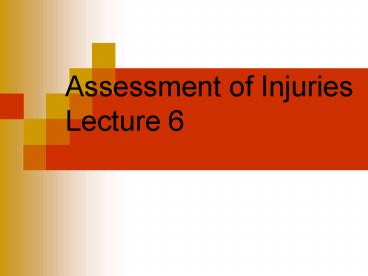Assessment of Injuries Lecture 6 - PowerPoint PPT Presentation
1 / 20
Title:
Assessment of Injuries Lecture 6
Description:
Assessment of Injuries Lecture 6 Assessment with a sports related injury the athletic therapist is expected to evaluate the situation , assess the extent and ... – PowerPoint PPT presentation
Number of Views:648
Avg rating:3.0/5.0
Title: Assessment of Injuries Lecture 6
1
Assessment of InjuriesLecture 6
2
(No Transcript)
3
Assessment
- with a sports related injury the athletic
therapist is expected to evaluate the situation ,
assess the extent and seriousness of the injury
and determine the necessary next step - ie. treatment, referral to physician, hospital
etc
4
Assessing an Injury
- History,
- Observation,
- Range of motion,
- Special tests and
- Palpations
5
History
- history taking requires practice and patience and
involves asking lots of questions - the therapist must listen and establish a rapport
with the athlete - a complete history includes
- primary complaint , mechanism of injury , extent
of pain, disability due to the injury , pervious
injuries and family history
6
(No Transcript)
7
Observation
- is a visual analysis of the overall appearance,
symmetry , motor function , posture and gait of
the individual - often the therapist will see the injury happen,
however many times they will not - in observation the therapist will note the
individuals willingness to move, ability to move,
did they walk in, crutches etc
8
(No Transcript)
9
- here a posture assessment may be performed
- inspect the injury site
- deformities, discoloration , swelling , scars,
10
Range of Motion
11
(No Transcript)
12
I) Active Range of Motion
- shows their ability and willingness to move
- is joint motion performed voluntarily by the
individual - determines possible damage to contractile tissue
- measures muscle strength
13
II) Passive range of motion
- body part is move with no assistance from the
injured individual - distinguishes injury to noncontractile tissue
(bone, ligament, bursae)
14
III) Resisted movement
- outside resistance is added to the movement
- isometric contraction
- assess muscle strength
15
Special Tests
- 1) Stress tests
- each body segment has a series of special tests
to assess joint function and integrity - test ligaments, intra-articular structures,
impingements and joint capsule stability
16
(No Transcript)
17
- 1) Neurologic testing
- nerve roots named by where they depart the
spinal column - each nerve root supplies nerve impulses to a
series of muscles and an area of skin - myotome a group of muscles innervated by a
single nerve root - dermatome a region of skin supplied by a
single nerve root
18
- 3) reflex testing
- exaggerated, distorted or absent reflexes
indicate degeneration or injury to the nervous
system - most familiar patella reflex or knee jerk (L3)
19
Palpation
- bilateral palpation of paired anatomical
structure can help to detect - temperature changes, swelling, point tenderness,
crepitus, muscle spasm, pulses and sensations - palpate painful area last, start on uninjured
side and compare
20
(No Transcript)































